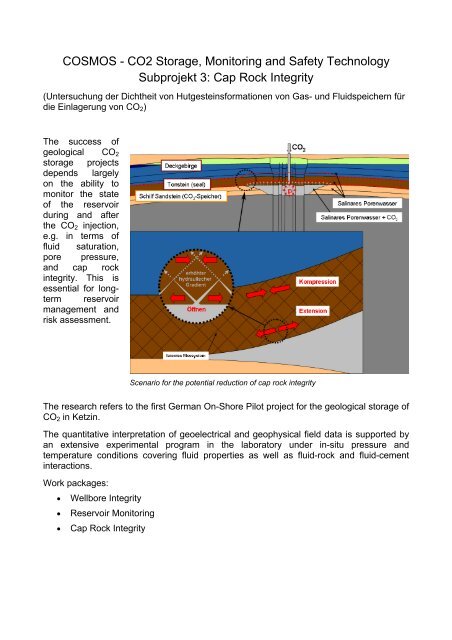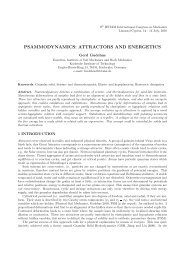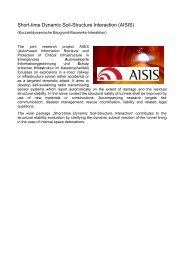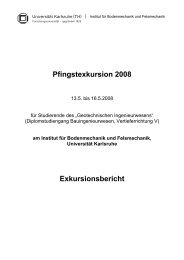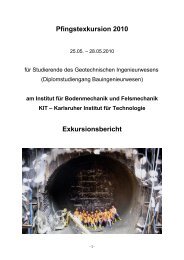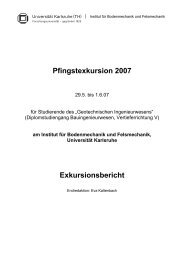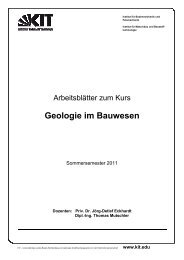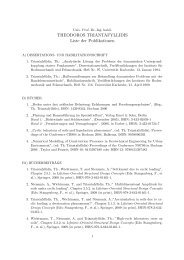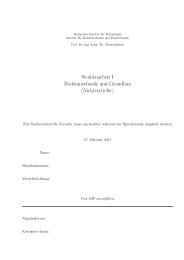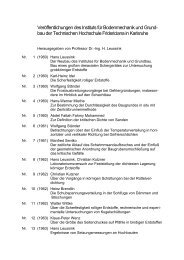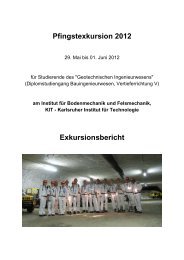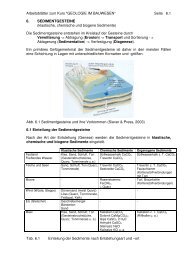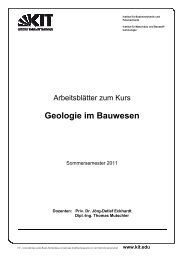COSMOS - CO2 Storage, Monitoring and Safety Technology ...
COSMOS - CO2 Storage, Monitoring and Safety Technology ...
COSMOS - CO2 Storage, Monitoring and Safety Technology ...
You also want an ePaper? Increase the reach of your titles
YUMPU automatically turns print PDFs into web optimized ePapers that Google loves.
<strong>COSMOS</strong> - <strong>CO2</strong> <strong>Storage</strong>, <strong>Monitoring</strong> <strong>and</strong> <strong>Safety</strong> <strong>Technology</strong><br />
Subprojekt 3: Cap Rock Integrity<br />
(Untersuchung der Dichtheit von Hutgesteinsformationen von Gas- und Fluidspeichern für<br />
die Einlagerung von CO 2 )<br />
The success of<br />
geological CO 2<br />
storage projects<br />
depends largely<br />
on the ability to<br />
monitor the state<br />
of the reservoir<br />
during <strong>and</strong> after<br />
the CO 2 injection,<br />
e.g. in terms of<br />
fluid saturation,<br />
pore pressure,<br />
<strong>and</strong> cap rock<br />
integrity. This is<br />
essential for longterm<br />
reservoir<br />
management <strong>and</strong><br />
risk assessment.<br />
Scenario for the potential reduction of cap rock integrity<br />
The research refers to the first German On-Shore Pilot project for the geological storage of<br />
CO 2 in Ketzin.<br />
The quantitative interpretation of geoelectrical <strong>and</strong> geophysical field data is supported by<br />
an extensive experimental program in the laboratory under in-situ pressure <strong>and</strong><br />
temperature conditions covering fluid properties as well as fluid-rock <strong>and</strong> fluid-cement<br />
interactions.<br />
Work packages:<br />
• Wellbore Integrity<br />
• Reservoir <strong>Monitoring</strong><br />
• Cap Rock Integrity
Project Data<br />
This work has been part (SP 3) of the<br />
Joint Research Project:<br />
<strong>CO2</strong> <strong>Storage</strong>, <strong>Monitoring</strong> <strong>and</strong> <strong>Safety</strong> <strong>Technology</strong> - <strong>COSMOS</strong><br />
Sponsored by the Federal Ministry of Education <strong>and</strong> Research (BMBF)<br />
in the framework of the special research program “Geotechnologies“<br />
under ident. no. 03G0630C<br />
Project partners:<br />
• GeoForschungsZentrum Potsdam (GFZ, coordinator)<br />
• DBI - Gastechnologisches Institut gGmbH, Freiberg<br />
• Vattenfall Europe AG<br />
• Karlsruhe Institute of <strong>Technology</strong> (KIT) – Institute of Soil Mechanics <strong>and</strong> Rock<br />
Mechanics (IBF), Institute of Mineralogy <strong>and</strong> Geochemistry (IMF),<br />
Forschungszentrum Umwelt (FZU), Institute of Technical Chemistry (ITC-WGT)<br />
• RWE Power, Essen<br />
Term period: 01.04.2005 - 31.03.2008<br />
Contributions from IBF Researchers:<br />
• Karl Balthasar<br />
• Gerd Gudehus<br />
• Thomas Mutschler<br />
• Sascha Rübel<br />
• Theodoros Triantafyllidis
Project Scope <strong>and</strong> Methodology<br />
Aims of the investigation of the cap rock properties above the Ketzin CO 2 storage<br />
reservoir:<br />
• Definition of suitable criteria to avoid any loss of cap rock integrity<br />
• Proof that these criteria are satisfied in the case of Ketzin<br />
• Development of „Best Practises“ for<br />
the characterization of cap rock in the<br />
framework of CO 2 storage reservoir<br />
exploration<br />
IBF focus <strong>and</strong> work packages:<br />
• Laboratory tests in various scales for<br />
the determination of the<br />
geomechanic properties of the cap<br />
rock<br />
• Experimental determination of<br />
geohydraulic parameters of cap<br />
rock, including their modification by<br />
new or reactivated fractures<br />
Cap rock samples from Ketzin<br />
• Numerical modelling of realistic<br />
deformations in the system reservoir-cap rock using the material properties above.
Geomechanic Properties<br />
Strength <strong>and</strong> deformation parameters were measured in:<br />
• A novel triaxial apparatus of RWE power with high-resolution measurement of volume<br />
change, in the construction of which the IBF was significantly involved <strong>and</strong> which was<br />
loaned to IBF for these investigations,<br />
• A large-scale triaxial cell for samples of 600 mm diameter <strong>and</strong> 1200 mm length,<br />
• Uni-axial compression with real sample deformation monitoring by DMS.<br />
The reservoir<br />
formation in<br />
Ketzin is<br />
s<strong>and</strong>stone <strong>and</strong><br />
the cap rock a<br />
Keuper claystone<br />
with visco-elastic<br />
behaviour. As<br />
long as cores<br />
from Ketzin were<br />
not yet available,<br />
experiments<br />
were also<br />
performed<br />
• on artificial<br />
compacted<br />
bentonite<br />
samples<br />
Triaxial apparatus with high-resolution volume monitoring<br />
Bentonite sample, Ketzin small-scall sample, claystone larg-scale sample after failure<br />
• on a similar Keuper claystone from Southern Germany.<br />
Comparison of results from small-sized <strong>and</strong> large-sized samples shows no significant<br />
scale effects.
Permeability Tests<br />
Test devices for geohydraulic properties consisted of<br />
• a special permeability cell, in which the sample was glued into a metal ring <strong>and</strong> fluid or<br />
gas could be penetrated from both sides, thus allowing a “permeation”, an<br />
“impregnation” <strong>and</strong> an “exsiccator” operation mode,<br />
• the permeability measuring periphery<br />
• a punching tool to force circular shear planes in a sample<br />
Permeability apparatus: flow principle, view <strong>and</strong> sample with punched circular shear plane<br />
The permeability of undisturbed cap rock samples is below 10 -16 m² . It can be much less<br />
depending on microfractures. CO 2 percolation leads to an increase or decrease.<br />
Responsible opposed reasons are the precipitation of Halit <strong>and</strong> Anhydrite, clogging the<br />
pore volume, <strong>and</strong> the advancing desiccation of the sample.<br />
Moderate CO 2 differential pressures seem to have no influence on permeability. With<br />
forced shear zones, the permeability is three magnitudes higher, but constant during<br />
percolation. Self-healing of fractures has been observed in some cases.
Finite-Elemente Simulations<br />
A finite element model was derived from the geological model <strong>and</strong> based on the<br />
parameters measured in the lab. Formation inclinations were variated<br />
Results show, that the deformation rate reaches its maximum in vertical direction near the<br />
borehole about one year of operation <strong>and</strong> falls decades below the critical rates in the cap<br />
rock.<br />
This means that the cap rock integrity is proven, the system safey rises after the end of<br />
CO 2 injection. Self-healing of open fractures <strong>and</strong> auto-inhibition effects may be expected.<br />
Axisymmetric FE model, principle strain rates in the cap rock formation


